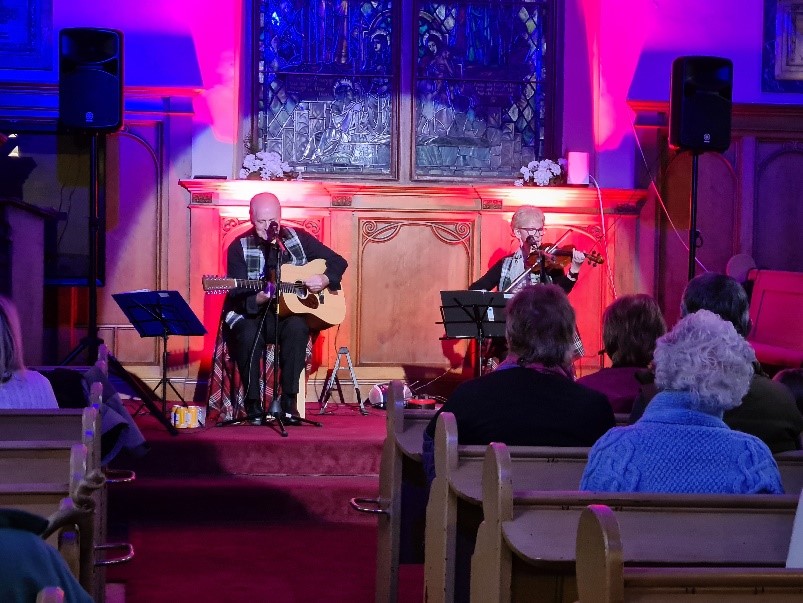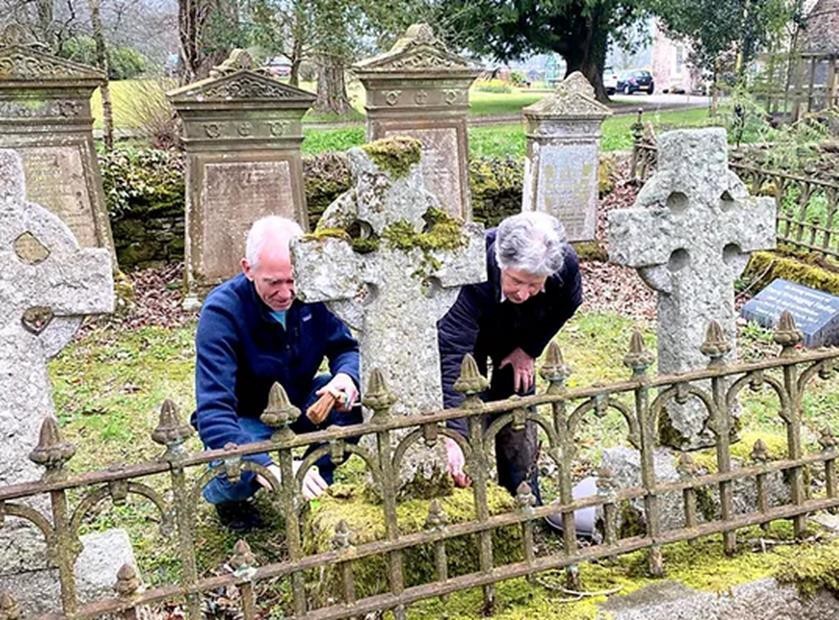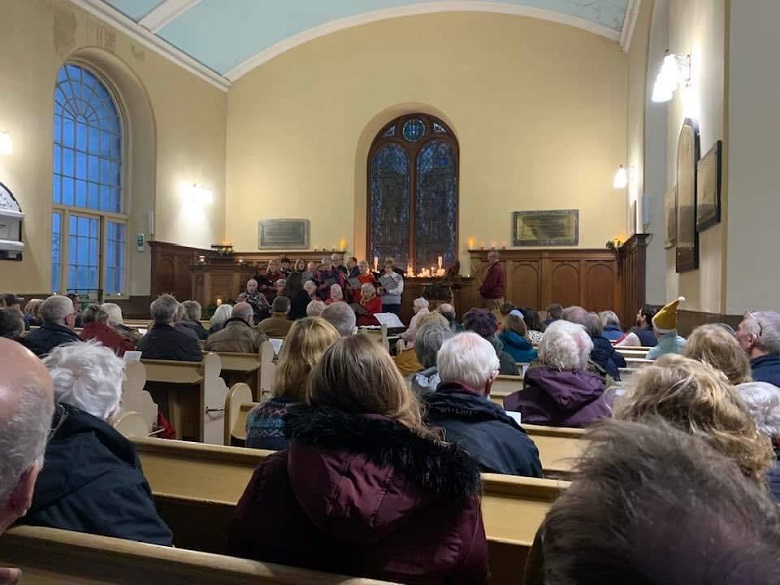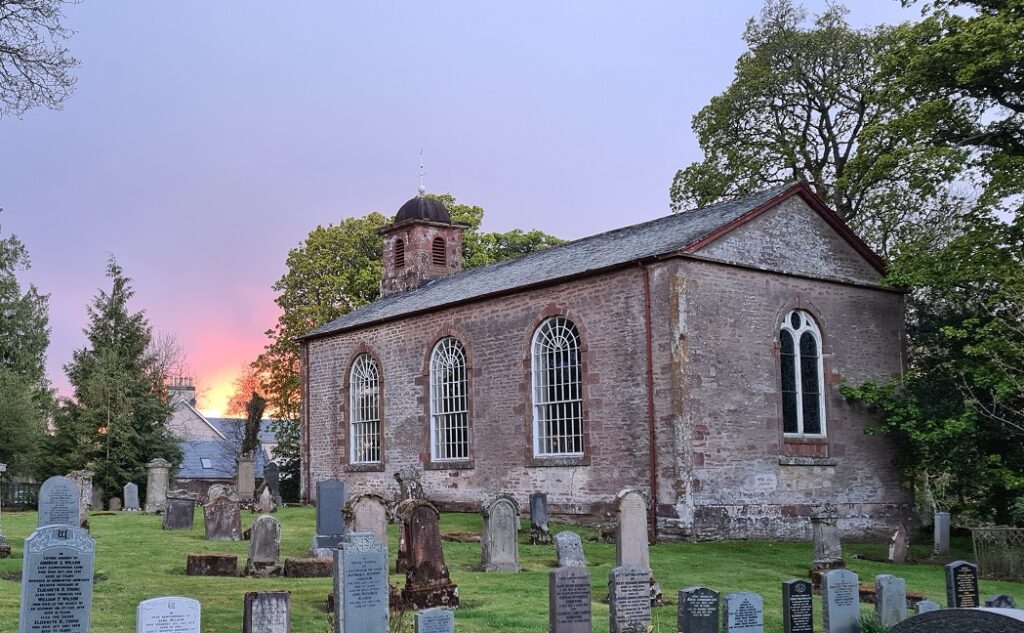Kilmaronock Old Kirk is a Category-B listed church dating from 1813, although the site probably dates back to the early medieval period.
Situated within the beauty of Loch Lomond & the Trossochs National Park, it served the communities of Gartocharn and Croftamie until its closure in 2017.
That same year the Kilmaronock Old Kirk Trust (KOKT) was formed, aiming to:
‘Deliver a fully restored historical church building to be available for flexible and sustainable community use, with an emphasis on heritage of the site for the benefit of locals and visitors’.
With over 100 members and eight trustees (who bring a variety of community and professional experience with them) our group have gone from strength to strength.
The road to ownership
The community held its first public meeting on the future of the kirk building less than a month after the doors closed in 2017.
This allowed the team to assess the interest in the project from the local community and to start recruiting potential trustees and volunteers for the project.
A local volunteer committee formed. The next step was to adopt a constitution becoming a Scottish Charitable Incorporated Organisation (SCIO) with the aim of buying the church for sustainable community use. Five months later the KOKT came into being.

Ecumenical Service – we continue as a listed place of worship by holding 6 services a year
KOKT commissioned a Feasibility Study and Business Plan carried out by independent consultants, which cost £20,000.
This was essential to enable an approach to the Scottish Land Fund for funding to purchase the kirk, car park and the glebe field. Funding for the purchase was awarded in November 2019 and the above assets actually transferred to KOKT in February 2021, delayed due to COVID.
Since then, KOKT has undertaken a renovation of the church exterior costing £300,000 and service works for the internal renovation. This was funded by several organisations including Historic Environment Scotland.
Various community and heritage focused activities including tours of the graveyard and non-denominational services have been carried out, as well as some funeral services with interment in the surrounding council run graveyard.
Below we’ve laid out the steps we took to get where we are today – hopefully it inspires other groups to do the same!

The Kirk as it appeared in 1977, zoom in on Canmore.
1. Create a Constitution
Our decision to move forward with SCIO registration grew from volunteer meetings.
Creating an open, round table discussion where everyone feels they can contribute is important in finding out what the group consensus is regarding the future use of the church.
Together you will need to draft a constitution. Think carefully about setting this up, as it both guides the future of your charity and its activities as well as determines what sources of funding are available to you – for example, if you still hold an occasional religious service then you can apply for funding from religious charities such as the National Churches Trust.
We had the benefit of having several volunteers who had experience setting up a SCIO, and the Office of the Scottish Charity Regulator (OSCR) website has plenty of guidance to help.
PRO TIP
In volunteer meetings, it’s important to assign tasks for next steps to ensure the process doesn’t stall. Obtaining SCIO status can be a time-consuming process that needs you to create a watertight constitution and be meticulous in writing application forms. This is also an opportune time to notify the owner of the building of your intentions.
2. Open a bank account
This is a crucial step that is worth starting ASAP as it can take time. In the initial volunteer meeting, elect a treasurer and second signatory to complete this task.
PRO TIP
We recommend electing someone with experience in accountancy or banking to do this part for you. Be thorough with checking paperwork and be sure to obtain trustees professional indemnity insurance.
3. Tell people what you’re doing
With a constitution and bank account in place, now’s the time to have a formal meeting with the building owner (Church of Scotland, private owner, local council etc).
Find out how they want to proceed with the ‘disposal’ of the building. This might be through open sale or preferred bidder. It’s worth preparing a short document outlining the work completed to date and signatures from the local community to clearly demonstrate public interest in your plans for the building.
PRO TIP
After this, host another public meeting. Update your local community on what you’ve done so far and gauge public support for the project again. It’s vital to have community support on your side and if people have cooled off, you may need to assess the feasibility of moving ahead with the project.
4. Figure out costs and how to raise them
Your next step is to prepare a feasibility study and a building survey. Prepare a detailed project brief of the work that is required. Put out to tender to 3 or 4 experienced consultants and select your consultant based on their tender report.
The Heritage Trust Network have a talent bank which can help find the right consultants.
The options appraisal and feasibility report will lay out potential uses of the building, income streams, and its ongoing management options. The building survey will assess its condition and what repair and maintenance works are required. Armed with these surveys – it would be a good time to speak to your local authority planning department about seeking listed building consent if your building is listed.
You may also need planning and other permissions if you are doing work to the building, do speak to your planning authority to find out more.
At this stage a RICS valuation of the asset was carried out as well as a business plan to cover the first five years and risk analysis of the project, e.g. purchase, repairs, adaptation work, and fundraising strategies.
All this cost £20,000. We knew the local community would help where they could, but it was also important for us to look further afield for funders. KOKT received funding from the Scottish Land Fund, Forth Valley and Lomond LEADER, the Architectural Heritage Fund and local donations to fund the feasibility work.
PRO TIP
It’s important to meet regularly with the consultant and key team members such as architects and quantity surveyors to determine project feasibility.
When satisfied that they have met your project brief arrange for them to prepare a final business plan and business plan summary. This is a useful document covering the key points that can be shared with fundraisers, current owners and members of the public to show what is achievable.
For us, the feasibility study, valuation, and business plan took six months to put in place.

Folk night August 2023
5. Secure funders and legal team
Armed with a business plan and with letters of support from the local community and politicians, it’s time to approach your main targeted funders.
Kilmaronock Old Kirk Trust received funding from the Scottish Land Fund in November 2019 – totalling £57,110 to cover 95% of asset purchase, legal fees, VAT assessment, and the cost of a project co-ordinator.
With funding in place, solicitors can be appointed. This will need to be a professional, however it’s always worth seeing if any lawyers within the wider community would be willing to do the work pro bono or for a reduced fee.
Your solicitors can determine what servitudes are needed for the building. For example, Kilmaronock Old Kirk is surrounded by a graveyard so we’re required to provide the local council with car park access for burials.
As with any legal process this can take some time. In our case the process took just over a year, but this will vary case by case.

Volunteers at work cleaning old gravestones
So you own the old kirk – now what?
Once ownership is finalised and the keys handed over, it’s important to keep up momentum to ensure the building can be bought back into use as soon as possible.
Once listed building consent was in place, we had assessors come into Kilmaronock Old Kirk for the boiler, fire extinguishers and electrics. We also got quotes to remove the moss from the roof.
After these initial works we moved on to implementing our business plan. Phase 1 ran from August 2022 to April 2023.
The initial sum of £195,000 was raised by grant funding from Historic Environment Scotland (who contributed 40%) and other funders including our local community.
However due to the impact of increased building material costs post COVID and the discovery of further structural issues during renovation, the budget we needed for works grew an additional £100,000.
Costs like this show the importance of continuous fundraising after the purchase and working closely to a business plan.
Work completed in April 2023. The building looks fantastic now! It has been re-slated in Aberfoyle slate, new leading has been added on the bellcot and the walls re-pointed in lime-mortar.

What’s HES doing to help?
Historic Environment Scotland is aware that religious bodies are currently undertaking a review of their estate, which includes considering some historic and listed buildings for disposal.
A wide array of social and economic issues bear on the difficult decisions being made by congregations and religious bodies. Many of these decisions, such as which buildings are to close and which to remain open, are being made at a local or regional level.
As a national body, we aim to support the groups making decisions about their buildings and the communities affected, including those not part of the congregations.
The goal is to find sustainable and viable long-term uses for these buildings, that recognises the cultural significance of these important historic places. Our Managing Change guidance on Use and Adaptation of Listed Buildings sets out our approach to change in listed buildings.
We also attend the Places of Worship Forum which focusses on helping find sustainable futures for places of worship.
And we have begun reviewing our guidance and the supporting information we have available to communities who might be impacted. We’re also working to strengthen existing networks of support and to help stakeholders and communities come together and pool resources, skills, knowledge and expertise. Email us to find out more.

Carols by Candlelight at the Old Kirk
Useful links
- We have an active grants program – you can read more about the grant and how to apply on our webpages.
- There is a team in HES who provide advice and support for community groups seeking to take a historic building into their care.
- The free step by step guide Your Church, Your Community is a great place to start for anyone concerned about their local heritage.
- If you are interested in your local place of worship, the Heritage Trust Network has this useful webpage filled with valuable resources that can help point the way forward.
- Other funders who supported KOKT included the National Churches Trust, Scottish Landfill Communities Fund, EB Scotland, Architectural Heritage Fund (AHF), FCC Communities Foundation, Foundation Scotland, Garfield Weston Foundation, the Wolfson Foundation, the Fraser Foundation, FEL, West Dunbartonshire Council, Forth Valley & Lomond CLLD and the Robertson Trust.

